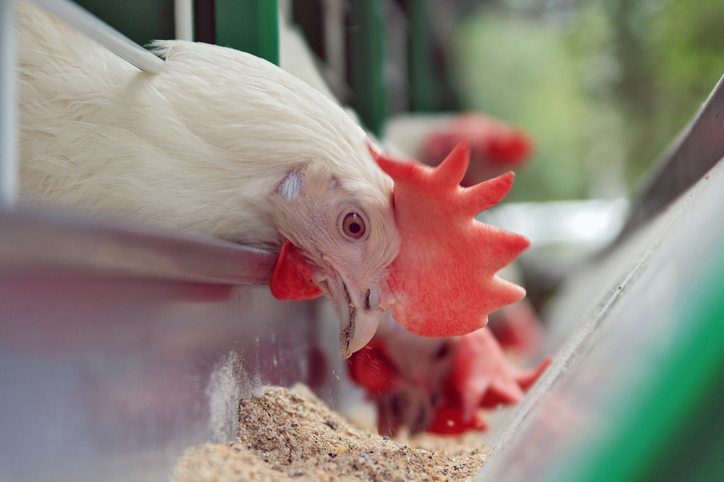
Broiler chicken feed comes in many forms, including mash, pellet and crumble. Mash typically results in some waste due to separation of grains (coarse particles) from other ingredients and supplements that result in the flicking behaviour of chickens. This problem is solved in pellet feed that produces uniform proportions and improved digestion of nutrients in broiler chickens. Crumbles add an additional step to pellet production by taking the pellets and crushing them into a consistency that’s courser than mash.
Advantages of pelleting for Chicken Feed Ingredients
There are several advantages of feeding poultry with pellets rather than mash.
- Pelleting reduces waste of chicken feed, water soiling, and selective eating behaviour in chickens
- Reduces bulkiness of feed by 15 – 18%
- Reduces Salmonella, E. coli, molds and more, and destroys growth inhibitors, like trypsin inhibitors and gossypol during processing
- The pelleting process solves mixing difficulties, incorrect particle sizes, and ingredient separation
- Results in the saving of 15-20% of broiler chicken feed cost
- Produces a higher nutrient density, increases the availability of Vitamin E and B12, and improves digestibility and ME value of certain ingredients, thereby increasing animal performance while creating superior feed efficiency
Studies such as those of Chewning et al. (2012) establish that pelleted feeds outperform comparable mash feeds in broiler chickens.
The Role of Pellet Quality in Chicken Feed
Pelleting involves conditioning raw materials by adding heat and water in the form of steam. The conditioned feed ingredients are then compressed into a dense mass and shaped to conform to the die against which they are pressed and cut. The heat and moisture is withdrawn through cooling so the ingredients can withstand moderately rough handling without excessive breakage. Pellets can then be crumbled into smaller particles to allow the chickens to consume the feed efficiently.
Click Here to Implement a Non-Medicated Poultry Stress Management Program
Ingredients, particle size, temperature, moisture, duration of conditioning, and pellet die parameters are key factors affecting the physical quality of pellets. Pellets with good physical quality show improved durability to withstand the various attritional forces on the pellet. This is especially true of those forces that are encountered during transportation of the feed to chicken farms. The process of crumbling imposes stress on the pellet and generates fines that lower the physical quality of the feed.
McKinney & Teeter (2004) reported that pelleting contributed 187 kcal/kg of diet due to broiler chickens resting more between meals. They also found that the energy value declined as pellet quality declined.
In a study by, Lemme et al (2006), they found that good quality pellets resulted in the highest weight gain of broiler chickens when compared to chickens offered poor quality pellets or coarse mash. Further, they discovered that chickens that ate mash required higher levels of lysine to achieve the same performance as pellet-fed chickens.
How Do Pellet Binders Improve Chicken Feed Quality?
Pellet quality depends on feed processing equipment, conditions, and feed formula. Pelletability of feed ingredients, determined by the presence or absence of natural binders and inclusion of synthetic binders in chicken feed, are key formula variables that affect pellet quality. Since natural binders are required in high inclusion levels to be effective and frequently have high variability, a good quality pellet binder allows feed manufacturers the opportunity for greater formulation flexibility, cost reduction per unit binding capacity, and consistent quality.
What Makes a Great Pellet Binder?
The highest quality pellet binders, such as Bentoli’s own Pelex® Dry, increase the efficiency of chicken feed by protecting feed from extreme heat and moisture. While 15 to 18% of fines are generated in the crumbling process, Pelex® Dry reduces that number to around 8%. This improves overall quality by increasing pellet durability and significantly reducing the amount of fines in chicken feed.
Additional Benefits of Bentoli’s Pellet Binders:
- Enhance the throughput of broiler chicken feed in pellet mill by 10 – 15%
- Reduce energy costs by approximately 3%
- Protect the physical quality of pellets during transport
Crumbles with the least fines can only be achieved with high quality pellets. Chicken feed performance improves significantly when fines in crumble feed are minimalized, as evidenced by Lemons & Moritz (2015) research. More fines in crumbles requires reprocessing that increases processing costs and decreases the nutritional value of ingredients. A study by Lilly et al. (2011) shows that feed conversion ratios in broiler chickens will improve significantly when the percentage of fines are reduced in broiler feeds. Broiler chicken feed trials with crumble feed containing high quality pellet binders showed a feed conversion ratio improvement of 4.8% when compared to crumble feed without a pellet binder. Pellet binders save time, money, and resources and can enhance the quality of your stock by improve the quality of their feed.



Very nice article, exactly what I needed.
Explanation regarding the energy value for pellet feed is very useful.
I’m not that much of a reader to be honest but your site is really nice, keep it up!
very good idea, infact I’m so much in love with this great idea because I suffer so much loss in feed wastages in my broiler farm. birds selecting feed ingredients in the trough makes me sick hereby wasting the valuable ingredients needed for their growth. I’m glad there’s a feed processing company in Nigeria is producing these form of feeds. Prayers of every poultry farmer just got answered now.
I’m a student studying animal science in South Africa and this article was a big help in completing a recent assignment. Keep up the Good work!
This article is very helpful to farmers, thanks for the post.
very good article,we can learn so much from your post